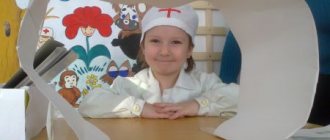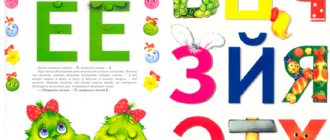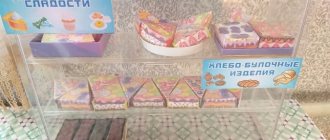Summaries of role-playing games material on the topic
Summary of a role-playing game-situation
"Vegetable and fruit shop"
Main area: socialization
Integration of areas: communication, cognition.
Tasks:
1. Strengthen the ability to most reliably display social relationships in the game.
2. To consolidate children’s ideas about the profession of a seller and the role of a buyer.
3. Develop in children the desire to do something pleasant and useful for another person.
4. Instill elements of social communication skills, develop role-based dialogue “seller-buyer”, “buyer-buyer”.
5. Reinforce the rules of behavior in public places, continue to form ideas about ethical standards.
6. Form positive relationships between children, develop moral feelings (orientation in the concepts of “good” and “evil”)
7. Instill in children respect for the work of adults.
8. Form a desire in children to observe the social roles of adults
9. Strengthen in children the ability to count to 5 and the ability to apply it in social reality.
Preliminary work:
- Conversations: “Let’s determine which store: department store, grocery, mixed”, “What we cook from vegetables and fruits”, “The health of your family”, “Delicious watermelon”
- Didactic games: “Who is the most polite”, lotto “Garden and vegetable garden”
- Productive activity: jointly with children and parents, creating a subject-developing environment for play (making berries from salt dough, sewing an apron and sleeves for a seller, making coins from colored cardboard, paper receipts).
- Reading fiction: L. Ulanova “The Right Purchase”, Y. Tuvim “Vegetables”, D. Kharms “About how the old lady bought ink”, D. Rodari “What do crafts smell like?”
- Looking at illustrations on the theme “Shop”
- Vocabulary work: cash register, check, showcase, price tag.
Main job:
The teacher involves children in a role-playing game through the creation of a problem situation, then during the distribution of roles he himself becomes a direct participant in the game and takes on the role of a seller with the consent of the other participants in the game (5 people), then this role is transferred to the child.
Progress:
Children and the teacher sit on chairs in a circle.
Educator: Guys, imagine, yesterday I was in a vegetable store with my daughter, I asked her to buy a couple of cucumbers, a couple of tomatoes for a salad and pay. She was scared and confused. Of course, it doesn’t matter, we will train. But I immediately thought, “Could the guys from my group be able to buy something on their own and how often do they go to the store with their moms and dads?”
Children: answer differently.
Educator: I have a proposal, let's play store, at the same time and see how and who knows how to make purchases. But not to an ordinary one, but to a fruit and vegetable store. Is this a grocery or department store?
Children: grocery.
Educator: That's right. Can I be the first seller?
Children: Yes
There is a distribution of roles. It is possible that during the distribution process, children will choose the roles of family or other couples (father-mother, husband-wife, mother-daughter, etc.).
In the group there is a counter with the “Vegetables and Fruits” emblem, on which fruits, vegetables, berries are laid out, price tags (labels with circles) are hung, the number of circles depicted corresponds to the cost of the goods, on the counter there is a cash register with a tray for coins and receipts, next to it there is a counter with bags in which purchases are placed, nearby there is a stand with sheets of green colored paper and a patch with large balls (as options for substitute items). Next to the “shop”, a subject-development environment has been created for playing “Home”.
The teacher puts on an apron and cuffs. Purses with coins are given to child shoppers. The seller takes a place behind the counter, buyers line up. In the queue, interaction takes place in a role-playing dialogue “buyer-buyer”.
Educator-seller: Our store sells only the best and freshest fruits and vegetables straight from the garden (if it’s winter, skip the phrase). Good afternoon, what did you want?
1st child buyer: Hello, please give me a tomato.
Educator-salesperson: Okay, of all the vegetables I love tomatoes the most. Perhaps you want a salad?
1 child buyer: Yes
Educator-seller: Then you need to take a bow for him.
1st child buyer: Let's do it.
Educator-seller: Tell me how much it costs, otherwise I can’t see the price tag from behind the counter.
1 child buyer: 3 tomato coins and 1 onion coin.
Educator-seller: Great, and that’s it...
1 child buyer: 4 coins.
Gives money to the seller.
The teacher-seller takes the money, puts the tomato and onion in a bag, knocks out a check at the checkout, puts the check in the bag, and gives it to the buyer.
Teacher-seller: thank you for your purchase, come to us again.
It is assumed that the child buyer will go “Home”, where he can lay out his purchases and return to the store again. This situation creates the preconditions for the emergence of a parallel storyline - the game of “House”.
2nd child buyer: Hello!
Teacher-seller: Good afternoon!
In the game, a negative situation may arise when some child shoppers do not want to stick to the line and will push each other, trying to get ahead. Naturally, the teacher must direct the game in a positive direction and say the phrase that the queue must be kept, each other must be respected and not interfere with the work of the seller, since the work of the seller is very hard.
Educator-seller: What did you want?
2nd child buyer: I need an apple and a pear.
Educator-seller: No problem! These are very healthy fruits that contain many vitamins. The apple is sweet and sour and sweet. Which one do you like?
2nd child buyer: Sweets.
Educator-seller: Okay. An apple is three coins, and a pear is 2 coins, and in total...
2nd child buyer: 5 coins.
The teacher-seller puts the purchases in a bag, the 2nd child-buyer hands over 5 coins.
Educator-seller: That's right, thank you for your purchase, come to us again. Goodbye.
2nd child buyer: Goodbye
Since initially the children know that this is a fruit and vegetable store, they only ask for them. But since fruit and vegetable stores usually sell berries, the teacher, while leading the game, himself invites child shoppers to buy berries.
Teacher-seller: Hello.
3rd child buyer: Hello.
Educator-seller: What should I serve you?
3rd child buyer: Give me carrots and banana.
Educator-seller: So you need both fruits and vegetables at once?
3rd child buyer: Yes.
Educator-seller: Why don’t you buy some berries too. We received fresh strawberries.
3rd child buyer: Yes, please.
There are no price tags on bananas and berries. It is assumed that the game will be structured in such a way that 3 child buyers will ask the price of the product.
Child buyer 3: How much do bananas and berries cost you?
Teacher-seller: Banana 3 coins, berry 1 coin, and the cost of carrots is indicated in the price tag.
3rd child buyer: 2 coins.
Educator-seller: Total of six coins.
The teacher-seller can name six coins with advanced learning, giving the child the opportunity to think, but if the child cannot count, you can say 4 and 2 coins. The teacher-seller packs the purchase.
Educator-seller: All the best, eat to your health. Say hi to your wife.
Child buyer 3: Thank you, I’ll pass it on. Goodbye.
This dialogue may give the child the idea to involve another player in the game, or to create a parallel storyline for the game “House”.
The teacher suggests switching roles and gives the main role of the seller to the child, and he himself joins the players, taking on the additional role of the buyer, and gets in line. If the plot begins to “slip,” the teacher uses indirect guidance of the game and influences the communication between the seller and the buyer.
Educator-buyer (addresses the seller): Good afternoon, could you please serve us faster, otherwise the queue is long, and I’m late for work.
Child seller: Yes, of course. What do you want?
If the 4 buyer is silent, the buyer-educator seems to bring him out for a conversation.
Educator-buyer: Woman, look at how many tasty and healthy things there are, oranges and apples and pears and cucumbers and tomatoes for salad, just ask the seller, he will serve you in an instant.
4 The child buyer expresses his request.
It is very important that children know how to introduce substitute objects into the game. If this does not happen, the teacher, using indirect guidance or direct role-playing dialogue, facilitates this process.
Educator-buyer (addresses another buyer): You know. Yesterday I bought such delicious watermelons here and I advise you to buy them, you won’t regret it. So round, but inside they are red, juicy, and the seeds are black-black, this means ripe watermelons.
Child buyer: Hello, please give me a watermelon.
A child seller can quickly get his bearings and take a ball as a watermelon; if this does not happen, the teacher helps him.
Educator-buyer: Look, it seems they brought you beautiful watermelons in boxes (points to a container with balls).
Child seller: Yes, of course, I’ll serve it now.
Calculation is in progress.
Educator-buyer (to the seller): Hello, give me also one watermelon for 3 coins, a fresh cucumber for a salad for 2 coins and a green salad, you don’t have it on the counter, but I really need it.
Child seller (couldn’t find a substitute item himself): We don’t have salad.
Educator-buyer (pointing to the rack with green colored paper): No, but there he is.
Child seller: I’ll serve it now. Costs 1 coin. And in total 3 and 2 and 1 will be 5 coins.
A calculation is made, possibly with the help of a teacher.
Educator-buyer (addresses the child-buyer): You and I are from the same house. Don't you recognize me?
Child buyer: No.
Educator-buyer: It's a pity. My name is Victoria. And you?
Child buyer: Boris.
Educator-buyer: Very nice. Are you by car?
The child buyer can find his way by finding a substitute item, but if he can’t, the teacher helps him, thereby involving him in a new storyline, this could be the game “Road” or “Gas station” or others.
Child buyer: No.
Educator-buyer (arranges chairs in the shape of a car or folds three-dimensional mobiles): And I’m in a car. Let me take you.
Child buyer: With pleasure.
Then either the game smoothly transitions into another storyline, or these lines pass simultaneously (“Home”, “Trip”, “Gas station”, etc.), the number of children increases, based on personal sympathies they are combined into groups of up to 6-7 maximum person.



